PR
X
キーワードサーチ
▼キーワード検索
カレンダー
サイド自由欄
鉄道模型・鉄道グッズリンク
鉄道関連書籍リンク
時刻表最新号
JTB時刻表

JR時刻表

鉄道雑誌最新号
鉄道ファン

鉄道ジャーナル

鉄道ピクトリアル

鉄道ダイヤ情報

Rail Magazine
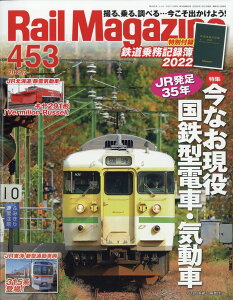
RM MODELS

j train

とれいん

鉄道模型趣味

N

旅と鉄道

楽天トラベルで旅に出よう

鉄道関連書籍リンク
時刻表最新号
JTB時刻表

JR時刻表

鉄道雑誌最新号
鉄道ファン

鉄道ジャーナル

鉄道ピクトリアル

鉄道ダイヤ情報

Rail Magazine

RM MODELS

j train

とれいん

鉄道模型趣味

N

旅と鉄道

楽天トラベルで旅に出よう
コメント新着
テーマ: 鉄道(23074)
カテゴリ: 鉄道ミニエッセイ
すでにご存知の方もいらっしゃるとは思うが、去る1月22日、3月16日にいよいよスタートが迫った横浜高速鉄道みなとみらい線・東急東横線・東京メトロ副都心線・東武東上線・西武池袋線の直通運転のダイヤ概要が発表された。
横浜高速鉄道・東急電鉄・東京メトロ・西武鉄道・東武鉄道各社のプレスリリース、および2月に東急電鉄が発表した新しい東横線の時刻表をまとめた運行計画は以下のとおり。
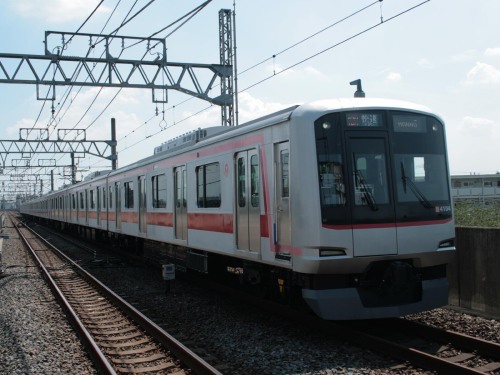
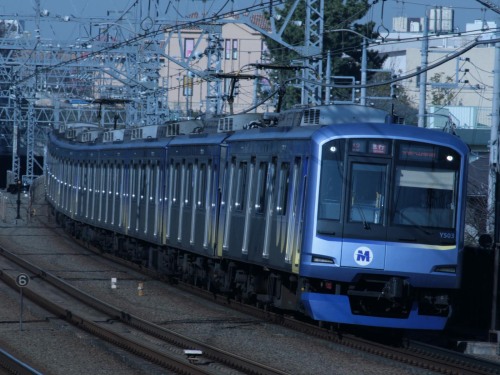
まずは東横線・みなとみらい線、副都心線、池袋線、東上線それぞれで列車種別が変わるということ。
新しい東横線の時刻表によると、平日日中の1時間あたりの副都心線直通列車14本の内訳は、各停列車6本、急行列車(副都心線各停)4本 、東横特急列車(副都心線急行)4本。このうち各停列車2本が新宿三丁目駅止まり、東横特急列車2本と各停列車2本が池袋線方面、急行列車4本と各停列車2本が和光市行き、東横特急列車2本が東武東上線方面への直通列車となる。
みなとみらい線・東横線の看板列車である「東横特急」は、副都心線内では急行列車、池袋線内では快速急行列車、東上線内では従来どおり和光市駅以西が各停として運行される。現行ダイヤの西武池袋線快速急行列車は練馬駅には停車しないが、3月16日より東横線・みなとみらい線直通の快速急行列車のみ練馬駅に(西武有楽町線新桜台駅・小竹向原駅にも)停車する。
平日夕ラッシュ時の東横特急列車と通勤特急列車も副都心線内では急行列車となる。池袋線直通列車は、池袋線内快速で運行される。急行列車は、日中時間帯は各停列車となるが、副都心線内朝ラッシュ時は急行列車または通勤急行列車としての運転となる。このほか朝ラッシュ時に千川駅発と池袋駅止まりの副都心線各停列車が新設される。
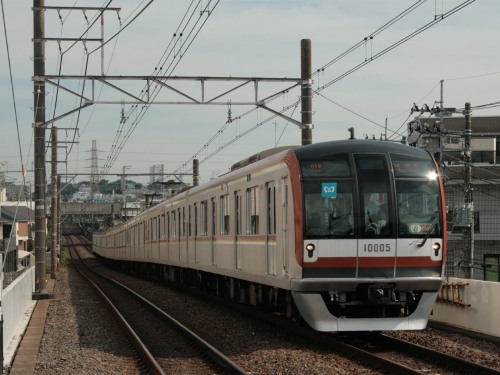
ここから僕の考察に入る。
まずは所要時間について。横浜駅~池袋駅間の所要時間を対比すると、東横特急・副都心線急行列車が38分、JR東日本湘南新宿ライン特別快速列車が35分と、湘南新宿ライン列車のほうが3分早い。しかし横浜駅~川越駅間の所要時間になると、JR東日本は大崎駅で湘南新宿ライン特別快速から埼京線快速へ乗り換え、東急・東京メトロ・東武は東上線直通の東横線内東横特急・副都心線内急行・東上線内各停と種別が変わる列車で対比してみると、東横特急・急行・各停が78分、JR東日本が湘南新宿ライン特別快速列車19分・乗換待ち時間3分、埼京線快速列車68分で合計90分。横浜駅~池袋駅ではJR東日本の勝ちだが、横浜駅~川越駅では乗換なしという利便性が功を奏し、東急・東京メトロ・東武の勝ちとなる。このため東急・東京メトロ・東武がJR東日本に対抗するためには、「乗換なしで川越へ」を大々的に宣伝する必要があると僕は考えている。
次に列車種別について書く。池袋線直通列車が、練馬駅停車という制約から現行ダイヤでは快速列車または準急列車として運行されているが、これが一気に料金不要種別で最も速い快速急行列車に格上げされた。東横特急列車を主力に置きたい東急電鉄の姿勢に、東京メトロと西武鉄道がそれぞれの最速達種別である急行と快速急行の種別を与える形で、好反応を示したようにも思える。自社線内では速いものの、地下鉄に乗り入れると各停になってしまう列車が多い中で、「『東横特急』は地下鉄でも、西武線でも速い」と東横特急の存在感を見せ付けることだろう。僕も個人的な考えとして、以前から地下鉄直通列車を急行または快速急行に格上げされることを望んでいた。しかし今改正でも相変わらず、東上線直通列車はすべて東上線内は各停列車としての運行である。川越市駅以西は各停列車では時間がかかりすぎる、もしくは日中の副都心線・東横線直通需要はないと考えられているのだろうか。
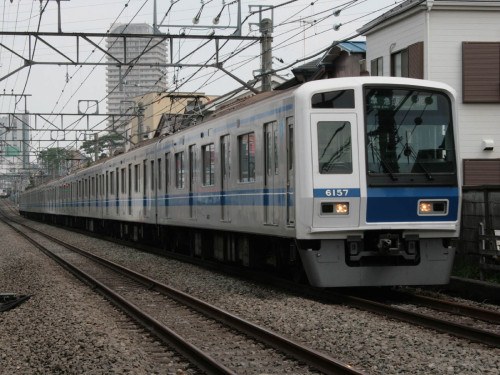

歴史的経緯をからめて考えてみると、かつて五島慶太の勢力下にあった東急電鉄と、その五島慶太と敵対関係にあった堤康次郎勢力下の西武鉄道が、永遠のライバルと言われた東急電鉄の車両・列車を乗り入れさせること、さらには料金不要の最速達種別を名乗る権利を与えることは、両社がいがみ合っていた過去を知る者の目には、相当な妥協、もしくは和解のようにも映るであろう。そして新宿三丁目駅に元町・中華街方面からの列車が折り返せるように引上線を設けたことは、当初の計画とは経路が違うものの、五島慶太の「東京横浜電鉄(東急東横線)新宿延伸計画」が長い年月を経てようやく実現したと捉えることもできる。
On January 22nd, the five railway companies, Yokohama Minatomirai Railway, Tokyu Corporation, Tokyo Metro, Tobu Railway, and Seibu Railway, announced the outline about their new timetables for going-through service between Hanno Station on Seibu Ikebukuro Line or Shinrin-koen Station on Tobu Tojo Line, and Motomachi-chukagai Station on Yokohama Minatomirai Railway Line via Tokyo Metro Fukutoshin Line and Tokyu Toyoko Line.
According to the press releases and new timetables, it is an important point that those five lines have a different pattern of train service and most trains change the name of service at the border station between the companies. For example, In case of a limited express train on Toyoko Line going through Fukutoshin Line and Ikebukuro Line, the name of service changes to express on Fukutoshin Line at Shibuya Station and does to rapid express on Ikebukuro Line at Kotake-mukaihara Station.
On the weekdays, fourteen trains go through Fukutoshin Line from Toyoko Line an hour. Six local trains (as local trains on Fukutoshin Line), four express trains (as local trains on Fukutoshin Line), and four limited express trains (as express trains on Fukutoshin Line) serve. More specifically, two local trains terminate at Shinjuku-sanchome Station, four express trains and two local trains are bound for Wakoshi Station, two limited express trains and two local trains go toward Ikebukuro Line, and two limited express trains toward Tojo Line. In the morning and evening, the limited express trains and the commuter limited express trains go through Fukutoshin Line (as commuter express trains) and Ikebukuro Line (as rapid trains). The express trains do (as express trains toward Ikebukuro Line or commuter express trains toward Tojo Line). Also, some local trains from Senkawa Station toward Toyoko Line and terminated at Ikebukuro Station from Toyoko Line started to serve.
From here, I would like to write about my opinions. First is about the comparison to JR East Shonan-shinjuku Line, second is the pattern of the train service.
It takes 38 minutes by going-through train on Toyoko Line and Fukutoshin Line between Yokohama Station and Ikebukuro Station, which is three minutes longer than that of Shonan-shinjuku Line. However, the travel time of the going-through service train between Yokohama Station and Kawagoe Station is shorter. It takes 78 minutes without transfer. In case of travelling JR lines, it does more 12 minutes via Shonan Shinjuku Line and Saikyo Line with a transfer.
About the pattern on Ikebukuro Line, the fast trains from Fukutoshin Line serve as the rapid trains or semi express trains on Ikebukuro Line because the trains have to stop at Nerima Station. However, those from Toyoko Line does as the rapid express trains, which is the second-fastest service. I see that Tokyo Metro and Seibu may accept Tokyu's request to serve the fast and convenient service on Fukutoshin Line and Ikebukuro Line.
On the other hand, all trains from Fukutoshin Line stop at all stations on Tojo Line. In my opinion, it would be better that the express trains on Fukutoshin Line serve as the express trains or the rapid express trains on Tojo Line to be faster and to extend its service to Shinrin-koen Station. Because of a few train services toward Tojo Line, some local trains from Fukutoshin Line need to extend the service to Kawagoeshi Station. However, Tobu Railway has no plan to extend trains toward Fukutoshin Line and Toyoko Line to farther than Kawagoeshi Station because of long distance and no demand.
Some railfans who know the history of Japanese railway may be surprised at the going-through service between Toyoko Line and Ikebukuro Line. In 1950s and 1960s, Tokyu Corporation and Seibu Railway competed to develop tourist attractions in Hakone, Kanagawa Prefecture. Also, the sidetrack at Shinjuku-sanchome Station for returning the trains from Toyoko Line may remind some railfans of an old extension plan to Shinjuku Station of Toyoko Line.
横浜高速鉄道・東急電鉄・東京メトロ・西武鉄道・東武鉄道各社のプレスリリース、および2月に東急電鉄が発表した新しい東横線の時刻表をまとめた運行計画は以下のとおり。


まずは東横線・みなとみらい線、副都心線、池袋線、東上線それぞれで列車種別が変わるということ。
新しい東横線の時刻表によると、平日日中の1時間あたりの副都心線直通列車14本の内訳は、各停列車6本、急行列車(副都心線各停)4本 、東横特急列車(副都心線急行)4本。このうち各停列車2本が新宿三丁目駅止まり、東横特急列車2本と各停列車2本が池袋線方面、急行列車4本と各停列車2本が和光市行き、東横特急列車2本が東武東上線方面への直通列車となる。
みなとみらい線・東横線の看板列車である「東横特急」は、副都心線内では急行列車、池袋線内では快速急行列車、東上線内では従来どおり和光市駅以西が各停として運行される。現行ダイヤの西武池袋線快速急行列車は練馬駅には停車しないが、3月16日より東横線・みなとみらい線直通の快速急行列車のみ練馬駅に(西武有楽町線新桜台駅・小竹向原駅にも)停車する。
平日夕ラッシュ時の東横特急列車と通勤特急列車も副都心線内では急行列車となる。池袋線直通列車は、池袋線内快速で運行される。急行列車は、日中時間帯は各停列車となるが、副都心線内朝ラッシュ時は急行列車または通勤急行列車としての運転となる。このほか朝ラッシュ時に千川駅発と池袋駅止まりの副都心線各停列車が新設される。

ここから僕の考察に入る。
まずは所要時間について。横浜駅~池袋駅間の所要時間を対比すると、東横特急・副都心線急行列車が38分、JR東日本湘南新宿ライン特別快速列車が35分と、湘南新宿ライン列車のほうが3分早い。しかし横浜駅~川越駅間の所要時間になると、JR東日本は大崎駅で湘南新宿ライン特別快速から埼京線快速へ乗り換え、東急・東京メトロ・東武は東上線直通の東横線内東横特急・副都心線内急行・東上線内各停と種別が変わる列車で対比してみると、東横特急・急行・各停が78分、JR東日本が湘南新宿ライン特別快速列車19分・乗換待ち時間3分、埼京線快速列車68分で合計90分。横浜駅~池袋駅ではJR東日本の勝ちだが、横浜駅~川越駅では乗換なしという利便性が功を奏し、東急・東京メトロ・東武の勝ちとなる。このため東急・東京メトロ・東武がJR東日本に対抗するためには、「乗換なしで川越へ」を大々的に宣伝する必要があると僕は考えている。
次に列車種別について書く。池袋線直通列車が、練馬駅停車という制約から現行ダイヤでは快速列車または準急列車として運行されているが、これが一気に料金不要種別で最も速い快速急行列車に格上げされた。東横特急列車を主力に置きたい東急電鉄の姿勢に、東京メトロと西武鉄道がそれぞれの最速達種別である急行と快速急行の種別を与える形で、好反応を示したようにも思える。自社線内では速いものの、地下鉄に乗り入れると各停になってしまう列車が多い中で、「『東横特急』は地下鉄でも、西武線でも速い」と東横特急の存在感を見せ付けることだろう。僕も個人的な考えとして、以前から地下鉄直通列車を急行または快速急行に格上げされることを望んでいた。しかし今改正でも相変わらず、東上線直通列車はすべて東上線内は各停列車としての運行である。川越市駅以西は各停列車では時間がかかりすぎる、もしくは日中の副都心線・東横線直通需要はないと考えられているのだろうか。


歴史的経緯をからめて考えてみると、かつて五島慶太の勢力下にあった東急電鉄と、その五島慶太と敵対関係にあった堤康次郎勢力下の西武鉄道が、永遠のライバルと言われた東急電鉄の車両・列車を乗り入れさせること、さらには料金不要の最速達種別を名乗る権利を与えることは、両社がいがみ合っていた過去を知る者の目には、相当な妥協、もしくは和解のようにも映るであろう。そして新宿三丁目駅に元町・中華街方面からの列車が折り返せるように引上線を設けたことは、当初の計画とは経路が違うものの、五島慶太の「東京横浜電鉄(東急東横線)新宿延伸計画」が長い年月を経てようやく実現したと捉えることもできる。
On January 22nd, the five railway companies, Yokohama Minatomirai Railway, Tokyu Corporation, Tokyo Metro, Tobu Railway, and Seibu Railway, announced the outline about their new timetables for going-through service between Hanno Station on Seibu Ikebukuro Line or Shinrin-koen Station on Tobu Tojo Line, and Motomachi-chukagai Station on Yokohama Minatomirai Railway Line via Tokyo Metro Fukutoshin Line and Tokyu Toyoko Line.
According to the press releases and new timetables, it is an important point that those five lines have a different pattern of train service and most trains change the name of service at the border station between the companies. For example, In case of a limited express train on Toyoko Line going through Fukutoshin Line and Ikebukuro Line, the name of service changes to express on Fukutoshin Line at Shibuya Station and does to rapid express on Ikebukuro Line at Kotake-mukaihara Station.
On the weekdays, fourteen trains go through Fukutoshin Line from Toyoko Line an hour. Six local trains (as local trains on Fukutoshin Line), four express trains (as local trains on Fukutoshin Line), and four limited express trains (as express trains on Fukutoshin Line) serve. More specifically, two local trains terminate at Shinjuku-sanchome Station, four express trains and two local trains are bound for Wakoshi Station, two limited express trains and two local trains go toward Ikebukuro Line, and two limited express trains toward Tojo Line. In the morning and evening, the limited express trains and the commuter limited express trains go through Fukutoshin Line (as commuter express trains) and Ikebukuro Line (as rapid trains). The express trains do (as express trains toward Ikebukuro Line or commuter express trains toward Tojo Line). Also, some local trains from Senkawa Station toward Toyoko Line and terminated at Ikebukuro Station from Toyoko Line started to serve.
From here, I would like to write about my opinions. First is about the comparison to JR East Shonan-shinjuku Line, second is the pattern of the train service.
It takes 38 minutes by going-through train on Toyoko Line and Fukutoshin Line between Yokohama Station and Ikebukuro Station, which is three minutes longer than that of Shonan-shinjuku Line. However, the travel time of the going-through service train between Yokohama Station and Kawagoe Station is shorter. It takes 78 minutes without transfer. In case of travelling JR lines, it does more 12 minutes via Shonan Shinjuku Line and Saikyo Line with a transfer.
About the pattern on Ikebukuro Line, the fast trains from Fukutoshin Line serve as the rapid trains or semi express trains on Ikebukuro Line because the trains have to stop at Nerima Station. However, those from Toyoko Line does as the rapid express trains, which is the second-fastest service. I see that Tokyo Metro and Seibu may accept Tokyu's request to serve the fast and convenient service on Fukutoshin Line and Ikebukuro Line.
On the other hand, all trains from Fukutoshin Line stop at all stations on Tojo Line. In my opinion, it would be better that the express trains on Fukutoshin Line serve as the express trains or the rapid express trains on Tojo Line to be faster and to extend its service to Shinrin-koen Station. Because of a few train services toward Tojo Line, some local trains from Fukutoshin Line need to extend the service to Kawagoeshi Station. However, Tobu Railway has no plan to extend trains toward Fukutoshin Line and Toyoko Line to farther than Kawagoeshi Station because of long distance and no demand.
Some railfans who know the history of Japanese railway may be surprised at the going-through service between Toyoko Line and Ikebukuro Line. In 1950s and 1960s, Tokyu Corporation and Seibu Railway competed to develop tourist attractions in Hakone, Kanagawa Prefecture. Also, the sidetrack at Shinjuku-sanchome Station for returning the trains from Toyoko Line may remind some railfans of an old extension plan to Shinjuku Station of Toyoko Line.
お気に入りの記事を「いいね!」で応援しよう
[鉄道ミニエッセイ] カテゴリの最新記事
-
683系「サンダーバード」に乗る Nov 23, 2021
-
"地下鉄のお嬢ちゃん"ステッカーの魅力 Sep 7, 2019
-
東急に「鉄道むすめ」がいない理由は「な… Aug 4, 2019
【毎日開催】
15記事にいいね!で1ポイント
10秒滞在
いいね!
--
/
--
© Rakuten Group, Inc.








